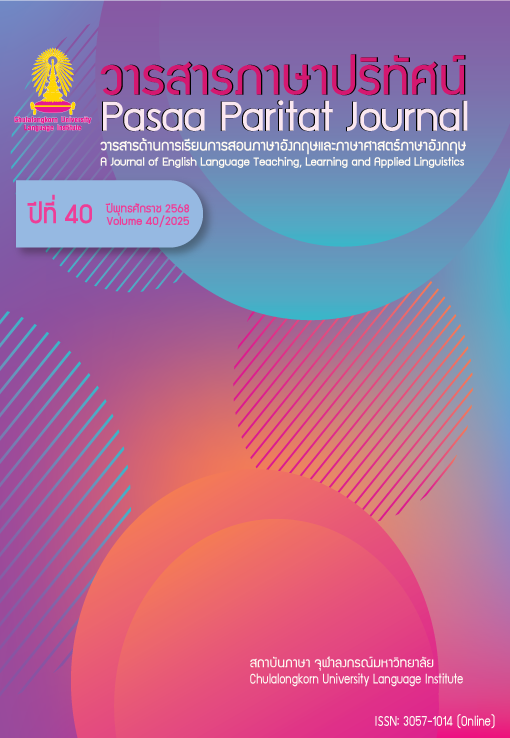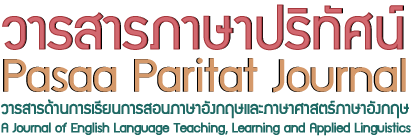Error Analysis of Business College Students’ Academic Essays: A Case Study
DOI:
https://doi.org/10.58837/CHULA.PPJ.40.1คำสำคัญ:
academic essays, errors in written academic essays, business college students, error analysisบทคัดย่อ
Bhutanese ESL students struggle in English despite studying it as a major subject from pre-primary through their schools and colleges. However, little is known about the errors that business college students make in their written academic essays. Thus, Corder’s (1974) procedural error analysis was adopted to examine errors in 217 academic essays written by the freshmen of a business college. Careful identification of the errors revealed four commonly recurring errors in the essays. These errors were collected, identified, described and explained with relevant findings obtained from the previous studies. The findings of this study are expected to inform the English language teachers of the types of errors that college students make and the sources of these errors. Based on the findings, the researchers recommend English language teachers to design exercises that can address these errors. However, as the study was restricted to a business college, it may not be possible to generalize the findings to other in-country colleges under the Royal University of Bhutan.
เอกสารอ้างอิง
Amiri, F., & Puteh, M. (2017). Error analysis in academic writing: A case of international post graduate students in Malaysia. Advances in Language and Literary Studies, 8(4), 141–145. https://doi.org/10.7575/aiac.alls.v.8n.4p.141
Bhutan Council for School Examinations and Assessment. (2013). A study of student achievements in English literacy and mathematics literacy at grade X (NEA technical report 2013-2014). Bhutan Council for School Examinations and Assessment. https://www.bcsea.bt/uploads/publications/A%20Study%20of%20Student%20Achievement%20in%20English%20Literacy%20and%20Mathematics%20Literacy%20in%20Class%20X%202013_1626327294.pdf
Bhutan Council for School Examinations and Assessment. (2015). National education assessment in Bhutan – A study of student achievements in English and mathematics literacy at class X (2013-2014). BCSEA journal of educational assessment. Assessment and Monitoring Division, Bhutan Council for School Examinations and Assessment. https://www.bcsea.bt/uploads/publications/BCSEA_Journal_for_Educational_Assessment_1626327137.pdf
Bhutan Council for School Examinations and Assessment. (2019). Education in Bhutan: Findings from Bhutan’s experience in PISA for development. National Project Center. www.education.gov.bt/wp-content/uploads/2021/09/Bhutan-PISA-D-National-Report.pdf
Brown, H. D. (2000). Principles of language learning and teaching (4th ed.). Prentice Hall.
Brown, H. D. (2007). Principles of language learning and teaching (5th ed.). Pearson Education.
Corder, S. P. (1967). The significance of learner’s errors. International Review of Applied Linguistics in Language Teaching, 5(4), 161–170. https://doi.org/10.1515/iral.1967.5.1-4.161
Corder, S. P. (1971). Idiosyncratic dialects and error analysis. International Review of Applied Linguistics, 9(2), 147–160. https://doi.org/10.1515/iral.1971.9.2.147
Corder, S. P. (1974). Error analysis. In J. P. B. Allen & S. P. Corder (Eds.), The Edinburgh Course in Applied Linguistics Volume 3: Techniques in Applied Linguistics (pp. 122–154). Oxford University Press.
Creswell, J. W. (2003). Research design: Qualitative, quantitative, and mixed methods approaches (2nd ed.). Sage.
Dulay, H. C., & Burt, M. K. (1974). Errors and strategies in child second language acquisition. TESOL Quarterly, 8(2), 129-136. https://doi.org/10.2307/3585536
Dulay, H., Burt, M., & Krashen, S. (1982). Language two. Oxford University Press.
Edge, J. (1989). Mistakes and correction. Longman.
Ellis, R. (1994). The Study of Second Language Acquisition. Oxford University Press.
Ellis, R. (1997). Second language acquisition. Oxford University Press.
Ellis, R., & Barkhuizen, G. P. (2005). Analysing learner language. Oxford University Press.
Ghani, M., & Karim, S. (2010). Error analysis of L2 writing. Kashmir Journal of Language Research, 13(1), 25–55.
Harmer, J. (2001). The practice of English language teaching(3rd ed.). Pearson Education.
Israel, G. D. (1992). Sampling the evidence of extension program impact. Program Evaluation and Organizational Development, IFAS, University of Florida. https://scholar.google.com/scholar?oi=bibs&cluster=10498211217022440732&btnI=1&hl=en
James, C. (1998). Errors in language learning and use: Exploring error analysis. Longman.
Jamtsho, S., Tshewang, J., Choda, Y., Tshering, N., & Kumar, S. (2018). Qualitative study factors affecting teaching and learning English in Minjiwong Central School. Bhutan Journal of Research and Development, 7(2), 68–76.
Kaweera, C. (2013). Writing error: A review of interlingual and intralingual interference in EFL context. English Language Teaching, 6(7), 9–18. http://dx.doi.org/10.5539/elt.v6n7p9
Kish, L. (1965). Survey sampling. Wiley.
Krejcie, R. V., & Morgan, D. W. (1970). Determining sample size for research activities. Educational and Psychological Measurement, 30(3), 607–610. https://doi.org/10.1177/001316447003000308
Lee, E. (2006). Rethinking taxonomy for analyzing EFL learners’ errors. Language Research, 42(1), 187–203.
Lightbown, P. M., & Spada, N. (1999). How languages are learned. Oxford University Press.
Lightbown, P. M., & Spada, N. (2006). How languages are learned (3rd ed.). Oxford University Press.
McKenna, M. C., Kear, D. J., & Ellsworth, R. A. (1995). Children’s attitudes toward reading: A national survey. Reading Research Quarterly, 30(4), 934–956. https://doi.org/10.2307/748205
Nemser, W. (1971). Approximative systems of foreign language learners. International Review of Applied Linguistics in Language Teaching, 9(2), 115–124. https://doi.org/10.1515/iral.1971.9.2.115
Phuket, P. R. N., & Othman, N. B. (2015). Understanding EFL students’ errors in writing. Journal of Education and Practice, 6(32), 99–106.
Polsky, J. (2018). Minding the gap: Migration of Indian English errors to Bhutan. Bhutan Journal of Research and Development, 7(2), 57–67.
Richards, J. C. (1971). A non-contrastive approach to error analysis. ELT Journal, 25(3), 204–219. https://doi.org/10.1093/elt/XXV.3.204
Richards, J. C., & Schmidt, R. (2002). Dictionary of Language Teaching Applied Linguistics (3rd ed.). Pearson Education.
Royal Education Council & Education Initiatives Private Limited. (2011). Bhutan’s annual status of student learning 2010. Royal Education Council.
Royal Education Council. (2012). The national education framework: Shaping Bhutan's future. The School Education and Research Unit. https://www.ibe.unesco.org/curricula/bhutan/bt_alfw_2012_eng.pdf
Royal Education Council. (2018). Evaluation of the school (PP-XII) English curriculum. https://rec.gov.bt/wpfd_file/evaluation-of-school-pp-xii-english-curriculum/
Sainsbury, M., & Schagen, I. (2004). Attitudes to reading at ages nine and eleven. Journal of Research in Reading, 27(4), 373–386. https://doi.org/10.1111/j.1467-9817.2004.00240.x
Seitova, M. (2016). Error analysis of written production: The case of 6th grade students of Kazakhstani school. Procedia-Social and Behavioral Sciences, 232, 287–293. http://doi.org/10.1016/j.sbspro.2016.10.022
Selinker, L. (1972). Interlanguage. International Review of AppliedLinguistics in Language Teaching, 10(3), 209–231.
Sermsook, K., Liamnimitr, J., & Pochakorn, R. (2017). An analysis of errors in written English sentences: A case study of Thai EFL students. English Language Teaching, 10(3), 101–110. http://doi.org/10.5539/elt.v10n3p101
Shrestha, A. (1979). Error analysis: A pragmatic approach. Contributions to Nepalese Studies CNAS, 6(2), 1–9. https://himalaya.socanth.cam.ac.uk/collections/journals/contributions/pdf/CNAS_06_02_01.pdf
Tashi, T. (2018). The investigation of grammatical errors in grade 10 students’ expository essays at Ura Central School, Bumthang district in Bhutan. Journal of Social Science and Humanities, 1(2), 7–13. http://doi.org/10.26666/rmp.jssh.2018.2.2
Tshomo, T., & Sherab, K. (2017). Bhutanese teachers’ and students’ perceptions on using literary texts as English as a second language (ESL) teaching and learning materials. Rabsel – the CERD Educational Journal, 18(1), 26–42. https://www.pce.edu.bt/wp-content/uploads/2019/07//RABSEL-Volume-XVIII-ISSUE-I.pdf
Tshomo, T., Choden, U., Sherab, K., & Zangmo, P. (2019). Teaching grammar using literary texts: An action research study with class eight students in Paro. Bhutan Journal of Research and Development, 8(2), 71–91. https://bjrd.rub.edu.bt/index.php/bjrd/issue/view/16/14
Ur, P. (2011). Grammar teaching: Research, theory, and practice. In E. Hinkel, & E. Hinkel (Ed.), Handbook of Research in Second Language Teaching and Learning Volume II (pp. 507–522). Taylor & Francis.
Yahya, A., Ishak, H. B. T., Zainal, Z., Faghat, L. J., & Yahaya, N. (2012). Error analysis of L2 learner’ writings: A case study. Proceedings of the 2012 International Conference on Language, Medias and Culture. IACSIT Press.
Yangdon, K. (2019). Identifying critical thinking skills of 2nd year, bachelor of language and literature students at Taktse, Trongsa. Bhutan Journal of Research and Development, 8(2), 55–70.
ดาวน์โหลด
เผยแพร่แล้ว
รูปแบบการอ้างอิง
ฉบับ
ประเภทบทความ
สัญญาอนุญาต
ลิขสิทธิ์ (c) 2025 วารสารภาษาปริทัศน์

อนุญาตภายใต้เงื่อนไข Creative Commons Attribution-NonCommercial-NoDerivatives 4.0 International License.



